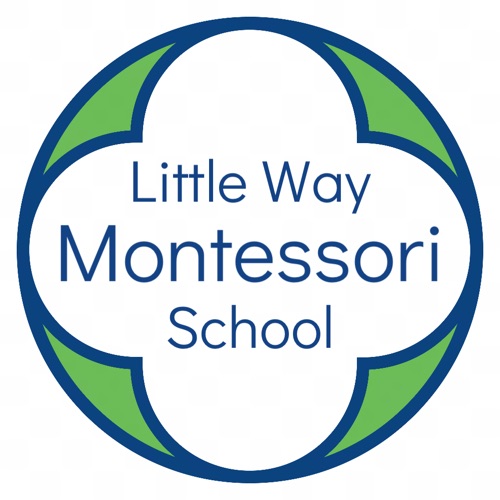Schedule
Hours
8:00-11:30 Monday through Friday, following the Plymouth Community Schools calendar.
Location
108 N Michigan St, Plymouth IN 46563
Curriculum
The early childhood program at Little Way is designed to support children in their natural growth through interaction with people and things in their environment. Children choose their own activities and work at their own pace for about two and a half to three hours each day. Other activities may include line time (circle or group time), outside time, and of course the transitions of arrival and pick up. A healthy snack is made available during the work time.
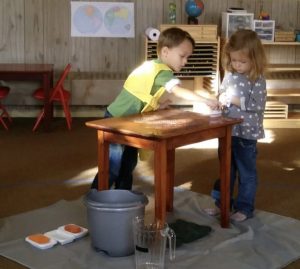 Practical Life
Practical Life
The foundation of the classroom, practical life activities foster concentration, coordination, a sense of order, and independence. Some activities build fundamental skills such as pouring, or using utensils and tools. Some focus on caring for the person, such as using a zipper or tying laces. There are activities for caring for the environment, including dusting, polishing, or sweeping. Food preparation is also in this area, and so are lessons in graceful movement and courteous interactions.
Much of the work in this area indirectly supports later reading and writing; children work from left to right and top to bottom, as they will read, and many activities strengthen the small movements of the hands and wrists necessary for writing.
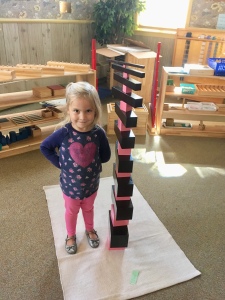 Sensorial
Sensorial
This area of the classroom provides opportunities to refine the senses, to develop the ability to discriminate among finer and more subtle distinctions. Most materials focus on visual discrimination for qualities such as size, length, thickness, shape, and color. There are also activities for discerning different pitches or volumes of sound, exploring different textures and other tactile features, and even smelling and tasting exercises. Of special interest are the stereognostic lessons, which challenge children to identify things through movement and touch while blindfolded — such as matching fabric samples, building a tower of blocks, or fitting together the cubes and prisms of the binomial cube.
Many of the Sensorial works lay a foundation for mathematical concepts. The quantity of ten, fundamental to the decimal system, is repeated in several materials such as the tower of cubes or the knobbed cylinders. Precision and order are embodied in the craftsmanship of the materials and the measured increments by which one object in a set differs from the next, as well as by the systematic processes involved in each work. Other works offer preliminary, concrete experiences with operations, geometry, and algebra.
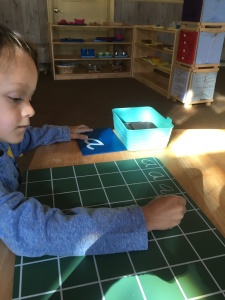 Language
Language
The core of language work is made up of three materials: sandpaper letters, movable alphabet, and metal insets. The sandpaper letters are large wooden cards with a letter shape cut from sandpaper. Through tracing this shape with her fingers and saying the primary sound of that letter, she develops the association of sound and symbol and the muscle memory of how that letter is formed. With the movable alphabet — small cutout letters arranged in a divided box — he can compose words, phrases, and sentences when his hand is not yet ready for pencil and paper. He listens for the sounds in what he wants to write, finds the corresponding letters in the box, and lays them out across his rug. The metal insets are a set of ten geometric shapes, both inset and frame. Tracing these with beautiful colored pencils develops the hand strength and coordination necessary for efficient and comfortable use of a writing instrument. These core materials are supplemented with additional activities involving small objects, picture cards, word labels, chalkboards, and so on. There are also materials to develop pre-reading skills such as matching, sequencing, concept development, vocabulary, and oral language.
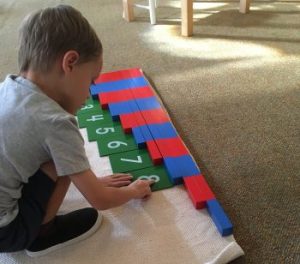 Mathematics
Mathematics
The math curriculum begins with numeration, developing a strong sense of the quantities 0-10 and the corresponding numeral symbols. In this first and fundamental work, children carry and order long rods from one to ten decimeters, counting the alternately colored decimeter segments. They use sandpaper numerals like sandpaper letters to learn the numeral symbol corresponding to each quantity and the proper formation path of each numeral. They count spindles into compartments labeled 0 through 9. They put numerals in order and lay counters under each in the proper quantities. Once the foundation of numeration is solidly established, children can work on one or more other branches, such as linear counting (learning the teens and tens, introducing skip counting, squaring, and cubing), the decimal system (units, tens, hundreds, thousands; composing large numbers, and decimal operations), simple operations and memorization-aiding games, measurement, graphing, fractions, money, and time. In each branch work begins with the most concrete materials, moving little by little into increasing abstraction, and finally including pencil and paper.
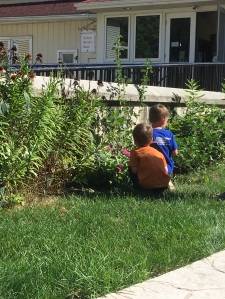 Cosmic
Cosmic
Dr. Montessori wrote about cosmic education as a way to ground children, to give them a sense of place, connection, and belonging. It entails looking at the universe with its galaxies, planets, and stars; the earth with its biomes, continents, oceans, and living things; and the particular classroom, home, community, and culture in which the children live and move. Thus, this area of the curriculum encompasses physical and cultural geography, botany and zoology, the physical sciences, and — peace education. As Montessori said, “We shall walk together on this path of life, for all things are part of the universe, and are connected with each other to form one whole unity” (To Educate the Human Potential 6). The exploration of the things of the universe and their many interconnections, including among people, leads to a loving concern for protecting, serving, and caring for all these things, which is the foundation of peace. Peace education in the early childhood classroom includes lessons and activities for exploring inner peace as well as peaceful interactions in kindness, generosity, and conflict resolution.
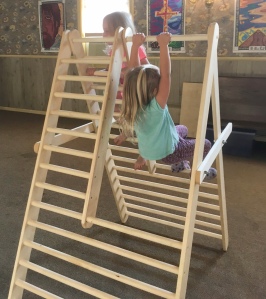 Arts and Movement
Arts and Movement
Arts in education are sometimes defended or promoted because of their beneficial effects on academic achievement. While those benefits are real, the arts are important for their own sake— for self-expression, exercising creativity, nourishing the spirit, and bringing beauty to all of life. A Montessori classroom offers opportunities to use a variety of media and explore topics such as art appreciation, color theory, and design. Children also have opportunities to sing, explore instruments, and develop their sense of rhythm, pitch, and dynamics.
Little children need to move. Movement is integrated throughout the classroom as children carry and manipulate materials, get a snack, or walk around to observe others’ work. There’s also recess, group activities like songs with motions or games, and individual activities like yoga or hopping between floor markers.
